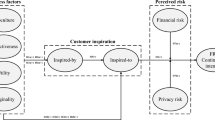Abstract
Facial Recognition Payment (FRP) is a new method of digital payment that recently gained popularity in China and South Korea. As of October 2019, although the number of users in China has exceeded 100 million, few studies have focused on this, and media coverage of FRP has not been adequately studied. Therefore, this study examines news articles using Latent Dirichlet Allocation (LDA) topic modeling to compare FRP related news in China and South Korea. The data of China comes from WeChat Public Platform, and the data of South Korea comes from Naver. Chinese search keywords is “人脸识别支付” (facial recognition payment), South Korea’s search key word is “안면 인식 결제” (facial recognition payment).Through data cleaning and comparative analysis, each subject is given an description and category, and the differences in 5 aspects of safety concern, application, development, technology and representative products are obtained. The rapid adoption of FRP in China can be explained by a lower public concern of personal information protection and the direct offering of FRP services to independent vendors by market leader Alipay. In South Korea, however, the increased public concern around privacy plays a key role in slower adoption, together with the dominance of franchise stores in the consumer market. It puts forward the suggestion for China and South Korea to learn from each other and for those other countries and enterprises striving to develop and utilize FRP.
Access this chapter
Tax calculation will be finalised at checkout
Purchases are for personal use only
Similar content being viewed by others
References
Shaw, M.E.M.D.L., Weaver, D.H., Mc Combs, M.: Communication and Democracy: Exploring the Intellectual Frontiers in Agenda-Setting Theory. Psychology Press (1997)
Bengston, D.N., Fan, D.P.: Roads on the US national forests: an analysis of public attitudes, beliefs, and values expressed in the news media. Environ. Behav. 31(4), 514–539 (1999)
eMarketer: China Mobile Payment Users 2019-Moving Toward a Cashless Society (2019)
The Korea Herald: Korea No. 1 worldwide in smartphone ownership, internet penetration (2018). http://news.koreaherald.com/view.php?ud=20180624000197&md=20180627003544_BL
Krasna, H., et al.: The future of careers at the intersection of climate change and public health: what can job postings and an employer survey tell us? Int. J. Environ. Res. Pub. Health 17(4), 1310 (2020)
Park, S.U., Ahn, H., Kim, D.K., So, W.Y.: Big data analysis of sports and physical activities among korean adolescents. Int. J. Environ. Res. Pub. Health 17(15), 5577 (2020)
Kim, N.R., Hong, S.G.: Text mining for the evaluation of public services: the case of a public bike-sharing system. Serv. Bus. 14(3), 315–331 (2020)
Che, S., Nan, D., Kamphuis, P., Jin, X., Kim, J.H.: a cluster analysis of lotte young plaza using semantic network analysis method. In: 2021 15th International Conference on Ubiquitous Information Management and Communication (IMCOM), pp. 1–6. IEEE (2021)
Zhang, W.K., Kang, M.J.: Factors affecting the use of facial-recognition payment: an example of Chinese consumers. IEEE Access 7, 154360–154374 (2019)
Author information
Authors and Affiliations
Corresponding author
Editor information
Editors and Affiliations
Rights and permissions
Copyright information
© 2021 Springer Nature Switzerland AG
About this paper
Cite this paper
Che, S., Nan, D., Kamphuis, P., Kim, J.H. (2021). A Comparative Analysis of Attention to Facial Recognition Payment Between China and South Korea: A News Analysis Using Latent Dirichlet Allocation. In: Stephanidis, C., Antona, M., Ntoa, S. (eds) HCI International 2021 - Posters. HCII 2021. Communications in Computer and Information Science, vol 1420. Springer, Cham. https://doi.org/10.1007/978-3-030-78642-7_11
Download citation
DOI: https://doi.org/10.1007/978-3-030-78642-7_11
Published:
Publisher Name: Springer, Cham
Print ISBN: 978-3-030-78641-0
Online ISBN: 978-3-030-78642-7
eBook Packages: Computer ScienceComputer Science (R0)




